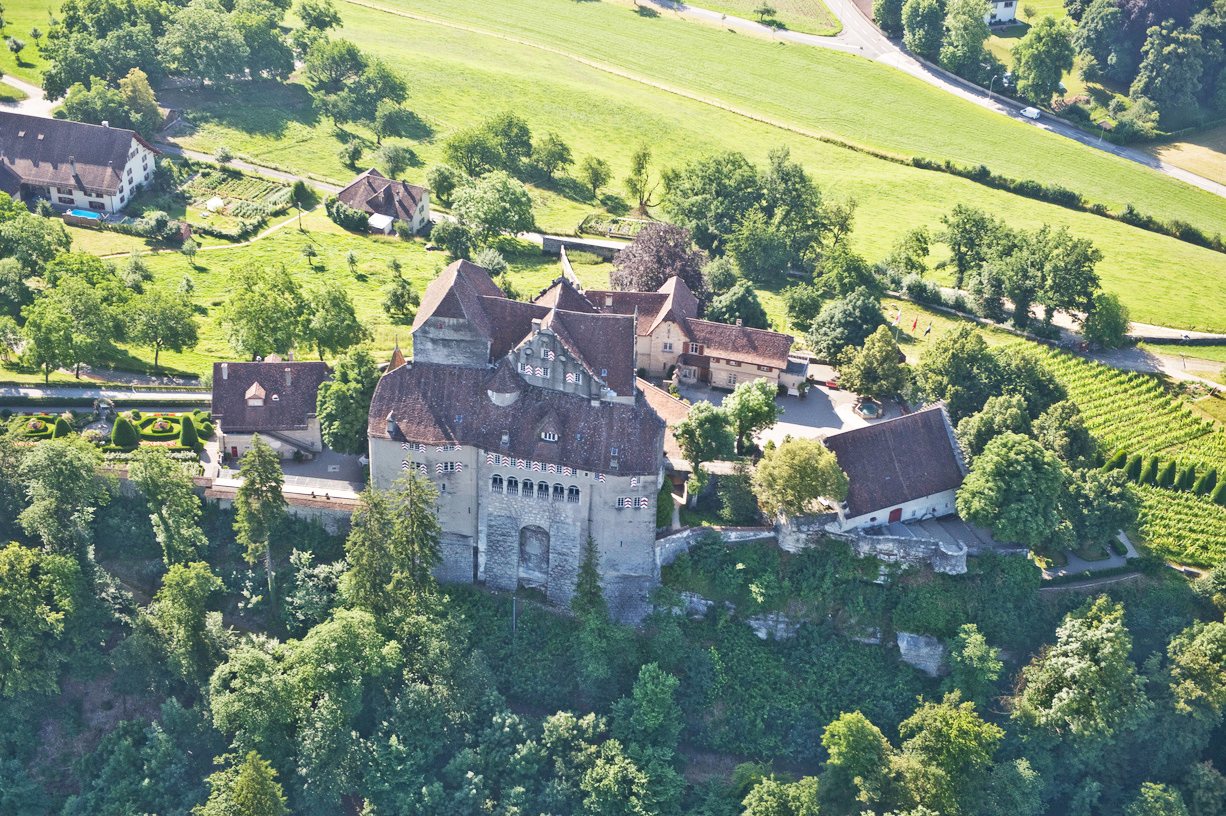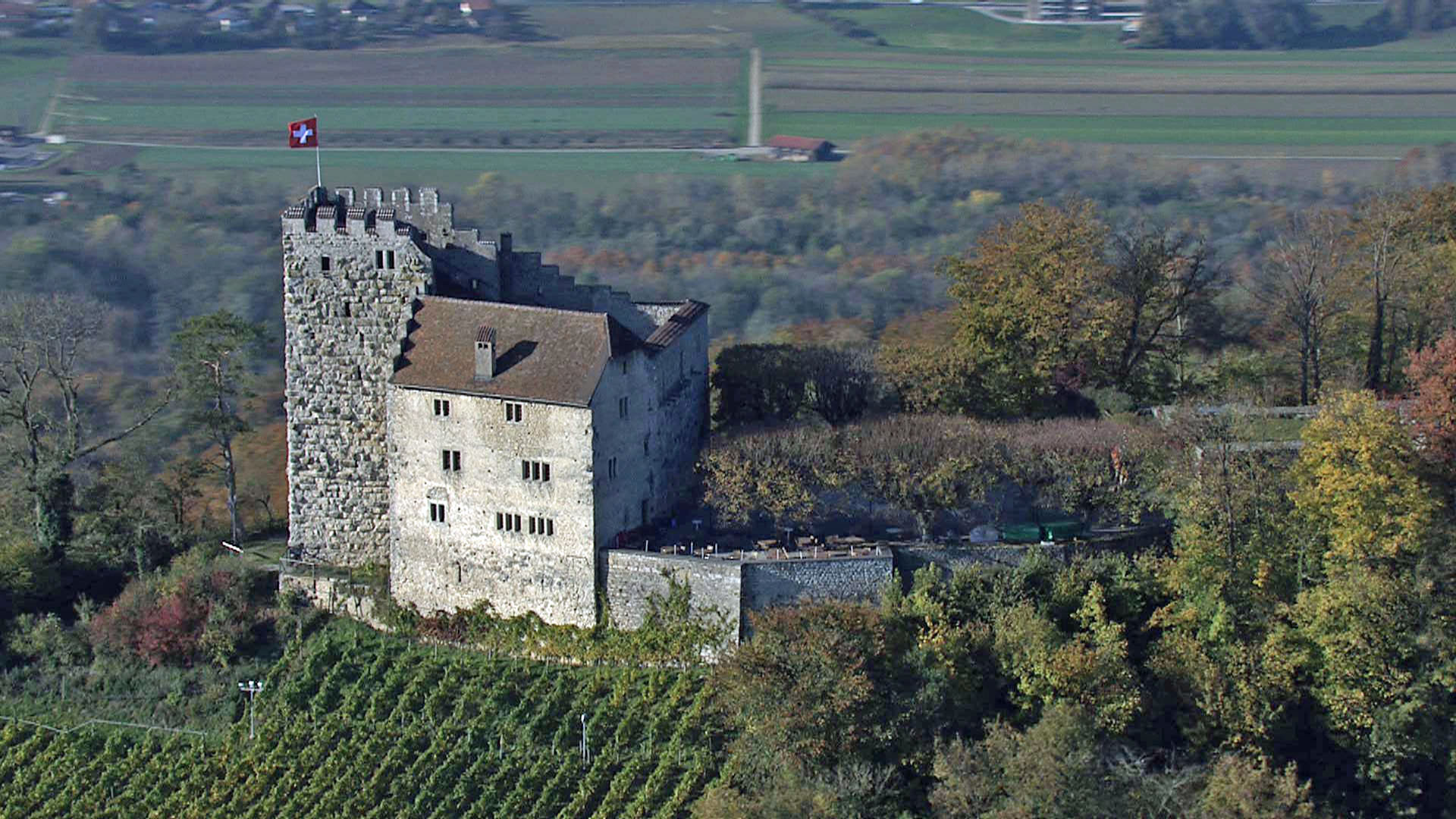How to run a castle as a business

Knights and dragons on the iPad or in a real castle? Competition from today’s digital world is fierce as Swiss castles try to attract more visitors. One canton is having success with living history events. But is it enough to keep out the financial bows and arrows?
Rural Aargau. Rolling green fields, vineyards and high on the hill, the baroque Wildegg CastleExternal link. Founded in the 13th century by the Habsburgs, the great ruling dynasty that – perhaps unknown to some – has its roots in the canton.
The building later passed to the Effingers, staying with them for 11 generations. The family liked to hang on to things – including its porcelain collection, which is completely intact because the ladies of the house used to insist on washing the pieces by hand themselves after mealtimes.
Given to the Swiss state by the last heir in 1912, the castle and its domain were handed over to the northerly canton of Aargau in 2013. It is now one of six locations under its Museum AargauExternal link umbrella, which includes three other castles, a monastery and a Roman legionary camp (see infobox).

More
Castles from the air
Living history
“We had an increase of 8% in visitors last year which is rarely heard of in the museum landscape in Switzerland, or elsewhere, especially when it’s not a new museum and we don’t have Picassos for example,” said director Jörn Wagenbach from his office at the castle. Last year there were 245,000 visitors, up from 82,000 around five years before.
The boost has mainly been down to Wagenbach’s predecessor Thomas Pauli – Wagenbach has only been in the job since December 2013 – who not only grouped the sites together, but invented the slogan “Geschichte am Spielplatz erleben (experience history where it happens)”.
“His speciality was to show authentic places and stories using all the senses, so you could listen to music, meet people in medieval, Roman or Baroque costumes who will then guide you through their homes and tell their personalised history,” Wagenbach said.
This year’s topic is “Watch out, infectious”, a look at 2,000 years of medicine and hygiene. Wildegg Castle will be looking at 19th century nervous illnesses. Its sister Hallwyl External linkis hosting events on castle hygiene, from baths to toilets.

More
Hallwyl castle’s toilets and bathtubs – up close
Constant challenges
Consistently coming up with an appealing theme is the biggest challenge of running the castles, Wagenbach said. Otherwise people won’t come back.
They also have to offer something for everyone – including being a place of quiet. But they also have to keep up with the times. “It’s a Sunday and you your kids have to decide, ‘do we want to play knights and dragons on our iPad or do we want to visit knights and dragons at Lenzburg Castle?’ Lenzburg Castle has to have a very good offer to be more attractive than an iPad game,” Wagenbach said.
Of course, the museum tries to remain authentic, without veering into the realm of “Disney” style dressing up, he added.
Castles also cost a lot to run, especially if they have a museum. “This is also a business, it’s not making money, it’s costing money, taxpayers’ money and this is one of the reasons we need to look at what our purpose is,” Wagenbach said.
Thus the castles can also be rented out for events, and there are cafés and gift shops. It is no coincidence that Wagenbach, a German national with a background in culture, also brings 17 years of PR and commercial knowledge to his new job. He has worked, among others, for Zurich Airport.
Tourism position
According to a Switzerland TourismExternal link statement, guests mostly come to Switzerland because of its spectacular nature.
But Chillon Castle, on the banks of Lake Geneva, counted nearly 350,000 visitors in 2013, 74% from abroad, with a rise in Asian visitors in particular, the tourist office stated. It also observes that medieval festivals are enjoying increasing popularity.
That castles have big competition from the Alps and cities has been confirmed by a report commissioned by Museum Aargau and compiled by the Gottlieb Duttweiler Institute.External link Castles are not associated with Switzerland the way the Loire chateaux are with France, it concluded. Visitors, except for the big well-known ones, are mostly local.
This is a situation that Wagenbach would like to change and he is looking into a special “quality” label for castles in Switzerland – hence the commissioned report. The project is still in its initial stages, but there are close to 20 interested potential parties from across the country, he said.
It would also allow castles to pool resources, for example, by sharing travelling exhibitions. “We have to do a positioning at a national level,” Wagenbach said.
Funding and future
The report found that while castles’ offerings were “large and diverse”, some were lacking in resources and needed a more modern outlook.
Almost half are in private hands. But some have been bought by local communities from private individuals to ensure their historical legacy. Negotiations are, for example, currently underway for an association of prominent locals from tourism and architecture to buy the landmark Tarasp Castle in the eastern canton of Graubünden.
Others, like the five around Lake Thun, have already joined forces to improve their marketing. “This umbrella Thunersee SchlosserExternal link label is a real milestone,” said Christina Fankhauser, from the lakeside Oberhofen CastleExternal link, at the summer season launch. She hopes that her much-photographed castle will receive more physical visits.
It has taken a year to bring the label together, project leader Ariane Klein told swissinfo.ch. Apart from a joint website and brochure, there are also special packages such as a Lake Thun boat trip and entry to two castles.
“Modern visitors need more than just a museum,” she said. “They already have so many choices for their free time, so you have to offer something else, with a wow factor, so they will come back, also for a wedding or a company event.”
Swiss castles
There are 843 visible castles and ruins in Switzerland. The Swiss Castles Association says there are some regions with many castles, like Basel, but others, like the Alpine areas or the Jura, where there are only a few. Around 70 castles are open as museums.
According to Switzerland Tourism, the following are among the most popular Swiss castles: Chillon Castle, Lake Geneva Region: the most visited historic building in Switzerland. Residence and toll station of the Counts of Savoy.
Castelgrande, Bellinzona, Ticino: an important example of medieval defensive architecture in the Alps, UNESCO World Heritage site.
Thun Castle, Bernese Oberland: 12th century castle, constructed by the Dukes of Zähringen.
Gruyères Castle: 13th century abode marrying 800-years of history and Oscar winning aliens by the late HR Giger.
(Source: Switzerland Tourism, Swiss Castles AssociationExternal link)

In compliance with the JTI standards
More: SWI swissinfo.ch certified by the Journalism Trust Initiative









You can find an overview of ongoing debates with our journalists here . Please join us!
If you want to start a conversation about a topic raised in this article or want to report factual errors, email us at english@swissinfo.ch.